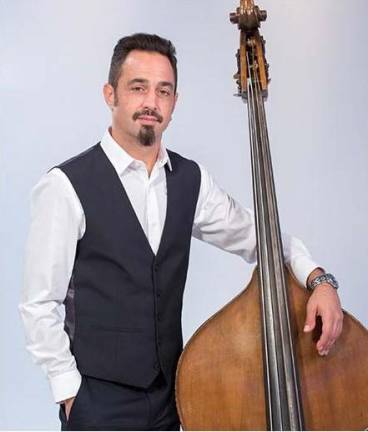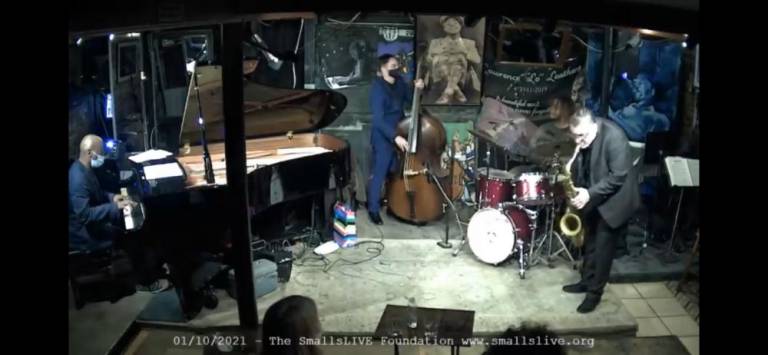Playing Like Mad
Jazz bassist Neal Caine on performing during the pandemic


Standing beside his dark-wooded bass in a slim blue suit at downtown jazz club, Smalls, musician, Neal Caine, doffs his mask and says, “I feel like Kevin Durant coming back after an injury, minus the money and the basketball skills.” It has been a year since the seasoned bassist and composer has played in this cherished crimson basement of wild drums and swirling saxophones, now closed to audiences due to coronavirus restrictions.
Like the Brooklyn Nets superstar he mentions, though, the St. Louis native still has it: that finger-dancing mastery on the thick strings and the jazzman-as-everyman humility that launched his career nearly thirty years ago as a keen player in New Orleans. Leading his quartet (including Jerry Weldon on tenor saxophone, Anthony Wonsey on piano, and Kyle Poole on drums) into the next song, a picture of a young Louis Armstrong alongside a mural of the gone-too-soon Lawrence “Lo” Leathers on the wall behind him, he makes the viewers streaming at home and the few in the audience bop.
Two nights earlier, as he sipped from a mug of whipped cream-topped hot chocolate in the wreath-lined tent of an East Village coffee shop, the silver-bearded Caine admitted that he didn’t really go to Tulane University to study political science, as was his major. Instead, he wanted to immerse himself in the hopping jazz scene, starting to play with such titans of the genre as the late Ellis Marsalis (patriarch of the Marsalis jazz dynasty) and Brian Blade in a “real fertile environment of young lions,” as he put it.
One day, upon returning to his apartment building, he found an envelope sitting on the lobby mantle and, after opening it, a ticket to Geneva to play in legendary drummer Elvin Jones’s quintet popped out. The next night, he was in the European city and was playing onstage with one of his idols. After a few years touring with the Jazz Machine, as the group was called, at Jones’s encouragement Caine moved to New York in the mid-‘90s.
Smalls had just opened around this time and, as the artist remembers, “Cats were hanging all night back then. Mitch [Mitchell Borden, the founder of Smalls] had a policy that it was always open, like twenty-four hours a day, so people were literally living there. It was a different scene, a good time.”
A hotbed for jazz with the Village Vanguard up the block and the Blue Note a train stop away, the West Village teemed with talent and Caine played countless shows. Sideman duty followed for several years but Caine eventually released his debut album as a leader, “Backstabber’s Ball” (2005, Smalls Records), which celebrated its fifteenth anniversary last year.
Sunken Treasure
Speaking of the record, which he made in a proper studio within a grand, high-ceilinged house back in New Orleans, Caine says, “I had two tenor saxophonists [Ned Goold and Stephen Riley] and no piano. I was really into that at the time. I’m really proud of that record. It was a wild statement of where I was at that time.”
The largely self-produced album is, in fact, a sunken treasure, an as-yet-unheralded gem that hearkens back to the Charlie Mingus of “The Clown” (1957, Atlantic) and “East Coasting” (1957, Bethlehem). With Caine’s alternately lilting and ominous bass slaps combined with Jason Marsalis’s ferocity on the drums, however, it stands as a compellingly progressive effort over a decade after its release.
Throughout the years, the musician has played all over the world at the biggest festivals while maintaining a steady gig with Harry Connick Jr., recording with such revered vocalists as the departed Betty Carter and Diana Krall, as well as composing film scores. He admits, however, that with the onset of the coronavirus pandemic and its subsequent havoc, it has been difficult for him as one ingrained to play before onlookers.
“Playing in front of people is special. There’s a certain energy, a spirit in the air, a vibe that you get from people listening. And they give you energy back, too,” he says. “It’s also just really what we do. It’s such a communal activity, especially for me as a bass player. I can practice at home all day but to apply what I do has to be with people.”
There is, in fact, a near audible, hard silence on the streets that, only a year ago, rattled with trumpet blasts and ramshackle drums, with moments of men and women wailing their hearts out. Caine, a workhorse artist, remains undeterred, though. “I recorded a trio record right before the virus in February of last year, a mix of originals and kind of hiply arranged standards,” he says. “It’s called Fingers of Doom and it’s just piano trio,” he continues, emitting his pride of the album and saying that he plans on releasing it soon.
For the night, though, as blue neon washed West 10th Street in a forlorn glow, Caine and his band played under the stairs below as if to a packed house, as if they were performing in the last jazz room on earth, swinging like mad.
Neal Caine continues to perform throughout the city. Follow him at his website (www.nealsugarcaine.com) for further details.